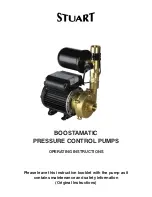
RKHBRD011~Y1
Indoor unit for air to water heat pump system
4P403581-1 – 2015.04
Installation manual
14
Example 1
The indoor unit is installed 5 m below the highest point in the water
circuit. The total water volume in the water circuit is 100 l.
In this example, no action or adjustment is required.
Example 2
The indoor unit is installed at the highest point in the water circuit.
The total water volume in the water circuit is 380 l.
Result:
■
Since 380 l is higher than 180 l or 270 l, the pre-pressure must
be decreased (see table above).
■
The required pre-pressure is:
Pg=(H/10+0.3) bar=(0/10+0.3) bar=0.3 bar
■
The corresponding maximum water volume can be read from
the graph: approximately 380 l for leaving water of 65°C and
approximately 250 l for leaving water of 80°C.
■
In case of 65°C leaving water, since the total water volume
(380 l) is not higher than the maximum water volume (380 l), the
expansion vessel suffices for the installation.
In case of 80°C leaving water, because the total water volume
(380 l) is higher than the maximum water volume (250 l) of the
expansion vessel, an additional expansion vessel must be
installed.
Setting the pre-pressure of the expansion vessel
When it is required to change the default pre-pressure of the
expansion vessel (1 bar), keep in mind the following guidelines:
■
Use only dry nitrogen to set the expansion vessel pre-pressure.
■
Inappropriate setting of the expansion vessel pre-pressure will
lead to malfunction of the system. Therefore, the pre-pressure
should only be adjusted by a licensed installer.
To be able setting the pre-pressure of the expansion vessel, the
switch box needs to be removed from the unit. How this must be done
is explained in the chapter
Connecting the water circuit
Water connections must be made. The location of the water inlet
connection and the water outlet connection on the indoor unit is
shown in the chapter
If air, moisture or dust gets in the water circuit, problems may occur.
Therefore, always take into account the following when connecting
the water circuit:
■
Use clean pipes only.
■
Hold the pipe end downwards when removing burrs.
■
Cover the pipe end when inserting it through a wall so that no
dust and dirt enter.
■
Use a good thread sealant for the sealing of the connections.
■
When using non-brass metallic piping, make sure to insulate
both materials from each other to prevent galvanic corrosion.
■
Because brass is a soft material, use appropriate tooling for
connecting the water circuit. Inappropriate tooling will cause
damage to the pipes.
Precautions when connecting field piping and regarding
insulation
The complete water circuit, inclusive all piping, must be insulated to
prevent reduction of the heating capacity.
If the indoor ambient temperature is higher than 30°C and the
humidity is higher than RH 80% then the thickness of the insulation
materials should be at least 20 mm in order to avoid condensation on
the surface of the insulation.
C
HARGING
WATER
Method for adding water
1
Connect the water supply to a fill valve (field supply).
2
Make sure the automatic air purge valve is open (at least 2
turns).
3
Fill with water until the manometer indicates a pressure of
approximately 2.0 bar. Remove air in the circuit as much as
possible using the air purge valves (refer to
). Air present in the water circuit might
cause malfunctioning of the heater kit (if installed).
4
For units with optional heater kit: remove air in the heater vessel
using the heater kit air purge valve.
Be careful not to deform the unit piping by using excessive
force when connecting the piping. Deformation of the
piping can cause the unit to malfunction.
■
The unit is only to be used in a closed water system.
Application in an open water circuit can lead to
excessive corrosion of the water piping.
■
Never use Zn-coated parts in the water circuit.
Excessive corrosion of these parts may occur as
copper piping is used in the unit's internal water
circuit.
NOTE
When using a 3-way valve or a 2-way valve in the
water circuit, the maximum changeover time of the
valve shall be less than 60 seconds.
NOTE
■
During filling, it might not be possible to remove all
air in the system. Remaining air will be removed
through the automatic air purge valves during first
operating hours of the system. Additional filling
with water afterwards might be required.
■
The water pressure indicated on the manometer
will vary depending on the water temperature
(higher pressure at higher water temperature).
However, at all times water pressure should
remain above 0.3 bar to avoid air entering the
circuit.
■
The unit might dispose some excessive water
through the pressure relief valve.
■
Water quality must be according to EU directive
98/83 EC.
Содержание RKHBRD011ADV1
Страница 45: ......
Страница 46: ......
Страница 47: ...V1 Y1 5 5 ...
Страница 48: ...4P403581 1 2015 04 Irrtum und technische Änderungen vorbehalten 04 2015 ...
















































